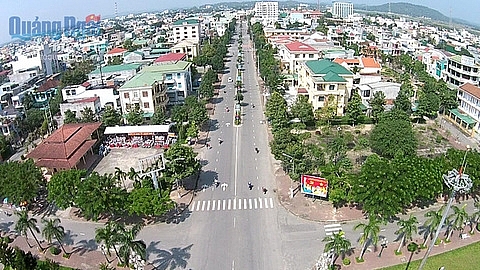Quang Ngai poised for real estate boom: experts
 |
| The real estate sector in the central province of Quang Ngai has strong potential to grow, thanks to its geographic attributes but still-low property prices that appeal to investors.-Photo cafef.vn |
Quang Ngai Province is strategically located in the central region and along the East-West economic corridor. It has convenient transport infrastructure and easy links with neighbouring economic zones and neighbouring countries by road, air and waterway systems. Because of this, its industrial, tourism and marine economic sectors are expected to boom in the next few years.
At present, the Dung Quat–Quang Ngai deep-water port can receive ships of up to 100,000 tonnes, making it an important gateway for importing and exporting goods. In terms of industry, Quang Ngai’s Dung Quat economic zone has an area of over 45,000ha. It is one of the five coastal economic zones that have been prioritised by the Government to receive investment in infrastructure and offer the strongest incentive schemes in Viet Nam today.
By the end of the second quarter of 2018, Quang Ngai’s regional domestic product (GRDP) was estimated to rise 9.23 per cent over the same period last year. The industrial sector increased by 16.15 per cent and service sector grew by 7.14 per cent.
In terms of tourism, total visitors to Quang Ngai in 2017 reached 810,000, including 69,000 international visitors, equal to 108 per cent of the year’s target and representing a year-on-year increase of 12 per cent. Total tourism revenue reached VND710 billion (US$30.4 million), up 10 per cent from 2016.
Big jump
According Quang Ngai City’s plans for 2016 to 2020, economic development will proceed in two basic directions: the urban economy and the marine economy. The exploitation of marine and island areas will become one of the city’s key economic sectors.
That orientation focuses on the province’s 130km-long coastline, with beautiful beaches such as Binh Chau, My Khe and Sa Huynh, as well as Ly Son Island. The province also possesses many unique cultural heritages and unique marine geographical features, which are a great foundation for the development of the city’s marine tourism economy.
To become a dynamic and friendly tourist city, Quang Ngai has concentrated its investment resources in urban planning. It intends to expand the city towards the sea, upgrade the transport infrastructure system. Some key strategic projects have been implemented, such as the dam upstream of Tra Khuc River, the Cua Dai Bridge linking the central coastal provinces, the Da Nang–Quang Ngai Highway and the Hoang Sa and Truong Sa routes along the banks of Tra River.
A number of key projects for tourism are also in the works, such as the Van Tuong Ecotourism Area, Emerald Island project, Anh Van Ecological Resort project in My Khe beach area and the 150ha Central Park project in Tinh Khe Commune.
Quang Ngai’s investments have created momentum for the real estate market in the province with series of new projects mainly on the two sides of the Tra Khuc River. An area of 252ha along the river has been the focus of detailed planning by the provincial People’s Committee.
Most of the land plots in this area have been handed over to investors for exploitation in accordance with the city’s plans.
Tran Xuan Thong, general director of Dat Xanh Da Nang, said the real estate market in Quang Ngai is still in the early stages of development and is far from its full potential, so real estate prices are much lower than in the neighbouring cities of the central region.
“In the near future, the development of transport infrastructure and a series of new projects, including the launch of Quang Ngai–Da Nang Highway at the end of July 2018, will be the driving forces for Quang Ngai to become a major economic and tourist province of central Viet Nam. This is also the lever for the breakthrough of the real estate market in Quang Ngai,” Thong told the cafef.vn.
In terms of obstacles facing the provincial real estate sector, Nguyen Phong, director of Quang Ngai Province’s Construction Department, said the most difficult step is compensation and the land clearance process. As the local people ask for land compensation equivalent to the market prices, investors must reach agreements with residents before they can start the projects.
“Quang Ngai Province has been providing favourable policies to attract investors in order to develop the property sector as well as enhance urban development overall. The province is ready to support investors in planning and administrative procedures to boost the real estate segment in the upcoming time,” Phong told Viet Nam News.
What the stars mean:
★ Poor ★ ★ Promising ★★★ Good ★★★★ Very good ★★★★★ Exceptional
Related Contents
Latest News
More News
- Main drivers for Vietnam’s digital economy future (December 03, 2025 | 11:35)
- Pivotal stage of growth paves way for rise in M&As (December 03, 2025 | 10:00)
- Positive projections for M&A interest from Thailand (December 03, 2025 | 09:40)
- Manifesting the first line of defence in cybersecurity (December 03, 2025 | 09:00)
- The transformational role AI can play in accounting arena (December 03, 2025 | 08:00)
- Unlocking 5G-AI potential in Singapore (December 03, 2025 | 08:00)
- Data-driven strategies vital for a fast-evolving nation (December 02, 2025 | 09:41)
- Policy to practice: how Vietnam can lead the region (November 26, 2025 | 16:03)
- Mobilising private capital at scale vital for climate battle (November 26, 2025 | 15:36)
- VILAF and Yoon & Yang launch Vietnam - Korea Practice Unit (November 26, 2025 | 15:16)

 Tag:
Tag:





















 Mobile Version
Mobile Version